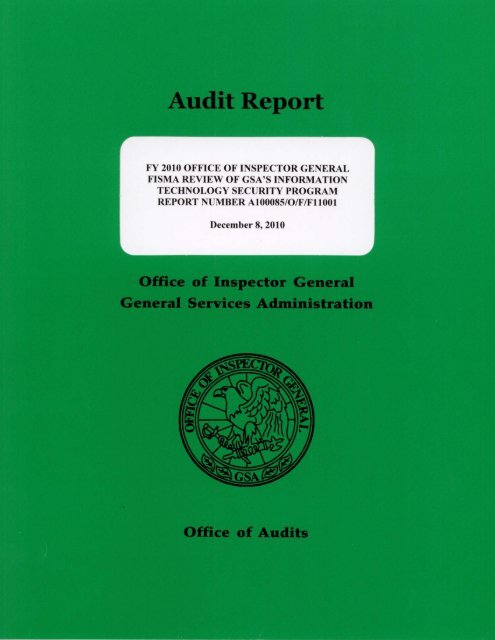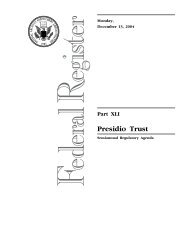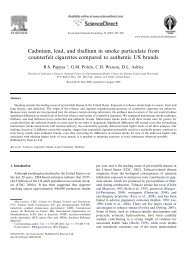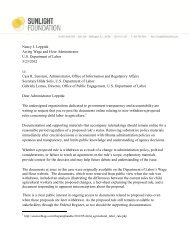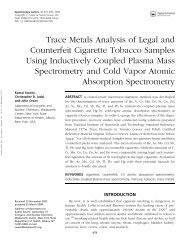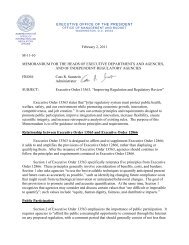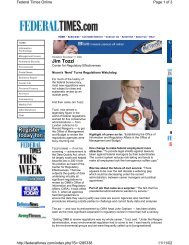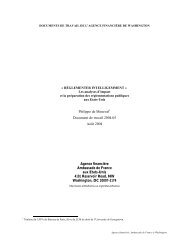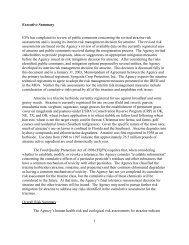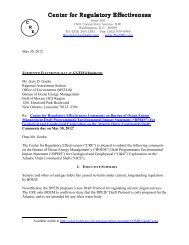FY 2010 Office of Inspector General
FY 2010 Office of Inspector General
FY 2010 Office of Inspector General
You also want an ePaper? Increase the reach of your titles
YUMPU automatically turns print PDFs into web optimized ePapers that Google loves.
<strong>FY</strong> <strong>2010</strong> OFFICE OF INSPECTOR GENERAL<br />
FISMA REVIEW OF GSA’S INFORMATION<br />
TECHNOLOGY SECURITY PROGRAM<br />
REPORT NUMBER A100085/O/F/F11001<br />
December 8, <strong>2010</strong>
Date: December 8, <strong>2010</strong><br />
To: Casey Coleman<br />
Chief Information <strong>Office</strong>r (I)<br />
Reply to Carolyn Presley-Doss<br />
Attn <strong>of</strong>: Deputy Assistant <strong>Inspector</strong> <strong>General</strong> for Finance and Information Technology<br />
Audits (JA-F)<br />
Subject: <strong>FY</strong> <strong>2010</strong> <strong>Office</strong> <strong>of</strong> <strong>Inspector</strong> <strong>General</strong> FISMA Review <strong>of</strong> GSA’s IT Security<br />
Program, Report Number A100085/O/F/F11001<br />
The Federal Information Security Management Act <strong>of</strong> 2002 (FISMA) directs <strong>Inspector</strong>s <strong>General</strong><br />
(IGs) to perform an annual independent evaluation <strong>of</strong> their respective agency’s information<br />
security program and controls for select systems. This audit report presents the results <strong>of</strong> the<br />
<strong>Office</strong> <strong>of</strong> <strong>Inspector</strong> <strong>General</strong>’s fiscal year <strong>2010</strong> review <strong>of</strong> the <strong>General</strong> Services Administration’s<br />
(GSA’s) information technology (IT) security program and reflects results from five system<br />
security audits conducted during the year. Appendix A provides the objective, scope, and<br />
methodology for the audit.<br />
On April 21, <strong>2010</strong>, the <strong>Office</strong> <strong>of</strong> Management and Budget (OMB) issued annual FISMA<br />
reporting instructions 1 for agencies and IGs. OMB directed IGs to assess agency information<br />
security performance in key areas, including certification and accreditation, configuration<br />
management, security training, incident response, remote access, and identity management.<br />
Further, OMB has directed Agencies and IGs to use Cyberscope, an Internet-based tool to<br />
respond to OMB’s FISMA questions.<br />
RESULTS OF AUDIT<br />
GSA’s Chief Information <strong>Office</strong>r (CIO) continues to take steps to develop, document, and<br />
implement an agency-wide IT security program. For example, the CIO has updated GSA’s IT<br />
Security Policy, published procedural guidance on a variety <strong>of</strong> information security topics, and<br />
expanded the IT security program to cover cloud computing technologies. However, we found<br />
that additional steps are needed to strengthen GSA’s IT security program in four key areas: (1)<br />
secure configuration <strong>of</strong> agency systems, (2) oversight <strong>of</strong> audit logging and monitoring practices,<br />
(3) implementation <strong>of</strong> multifactor authentication for systems processing sensitive information,<br />
and (4) encryption <strong>of</strong> data on agency laptop computers.<br />
1 OMB Memorandum M-10-15, <strong>FY</strong> <strong>2010</strong> Reporting Instructions for the Federal Information Security Management<br />
Act and Agency Privacy Management, April 21, <strong>2010</strong><br />
1
RECOMMENDATIONS<br />
To improve GSA’s IT Security Program and to ensure the security <strong>of</strong> GSA systems, data, and<br />
operations, we recommend that the GSA-CIO take actions to:<br />
1. Strengthen configuration management practices for GSA systems by:<br />
a. Increasing oversight <strong>of</strong> security <strong>of</strong>ficials’ application <strong>of</strong> baseline configuration<br />
requirements, and<br />
b. Expanding technical testing processes to include authenticated scanning.<br />
2. Work with system security <strong>of</strong>ficials to prioritize the implementation <strong>of</strong> audit logging and<br />
monitoring controls for GSA systems.<br />
3. Ensure that all systems that are remotely accessed implement multi-factor authentication,<br />
as appropriate.<br />
4. Implement an encryption solution for agency laptops that integrates into GSA’s network<br />
environment.<br />
EXPLANATION OF FINDINGS<br />
Expanding technical testing processes could improve configuration management <strong>of</strong> agency<br />
systems<br />
While the GSA-CIO has implemented a testing program with tools that identify vulnerabilities,<br />
improvements are needed to better secure agency systems and data. Specifically, we identified<br />
numerous weaknesses in all five systems reviewed resulting from security misconfigurations <strong>of</strong><br />
database or operating system s<strong>of</strong>tware. These weaknesses included database and operating<br />
system s<strong>of</strong>tware that was not patched or securely configured and lax password management<br />
practices for database administrator accounts. As a result, these systems and their sensitive data<br />
were placed at an increased risk <strong>of</strong> inappropriate access, modification, or destruction. GSA’s IT<br />
Security Policy requires all information systems be securely hardened and patched while in<br />
operation. National Institute <strong>of</strong> Standards and Technology (NIST) Special Publication 800-53 2<br />
requires organizations to configure the security settings <strong>of</strong> IT systems to the most restrictive<br />
mode consistent with operational requirements.<br />
Weaknesses occurred for two primary reasons. First, system security <strong>of</strong>ficials were not applying<br />
GSA’s IT Security Policy requirements for baseline configuration. Second, technical testing<br />
conducted by the GSA-CIO as part <strong>of</strong> GSA’s oversight was not comprehensive. To strengthen<br />
configuration management <strong>of</strong> GSA systems, we recommend that the GSA-CIO: (1) increase<br />
oversight <strong>of</strong> security <strong>of</strong>ficials’ application <strong>of</strong> baseline configuration requirements, and (2) expand<br />
technical testing processes by performing authenticated scans. Authenticated scanning would<br />
provide a more comprehensive view as to the implementation <strong>of</strong> GSA’s IT Security Policy and<br />
hardening guides by system security <strong>of</strong>ficials.<br />
2 NIST SP 800-53, Rev. 2, Recommended Security Controls for Federal Information Systems, December 2007<br />
2
Additional oversight by GSA’s IT security program could assist in ensuring that audit logging<br />
and monitoring controls are implemented for GSA systems<br />
While the GSA-CIO has published policy on audit logging and monitoring, we found<br />
inconsistent implementation <strong>of</strong> the policy for three <strong>of</strong> five systems reviewed, specifically:<br />
Database audit records, which would capture information such as the modification and<br />
deletion <strong>of</strong> data and administrative actions, were not generated for one system that<br />
contains Privacy Act information.<br />
Operating system audit records that monitor baseline system data, such as system<br />
performance, were not enabled for another system containing Privacy Act information.<br />
System security <strong>of</strong>ficials were not reviewing audit records for suspicious activity for<br />
another system containing sensitive information.<br />
As a result <strong>of</strong> not appropriately implementing audit logging and monitoring, system security<br />
<strong>of</strong>ficials may be unable to identify unauthorized activity or when GSA systems are<br />
compromised. Further, investigatory actions in response to security incidents may be hindered.<br />
GSA’s IT Security Policy requires that security auditing capabilities be employed on all GSA<br />
information systems and that audit records be reviewed frequently for signs <strong>of</strong> unauthorized<br />
activity and other security events.<br />
Inconsistent implementation occurred primarily because GSA, in its efforts toward enterprisewide<br />
continuous monitoring, has not prioritized the management <strong>of</strong> audit records for systems that<br />
contain sensitive information. To better detect potential security incidents, we recommend that<br />
the GSA-CIO work with system security <strong>of</strong>ficials to prioritize the implementation <strong>of</strong> audit<br />
logging and monitoring for GSA systems.<br />
Better planning could help ensure successful implementation <strong>of</strong> multifactor authentication for<br />
GSA systems<br />
Multifactor authentication involves accessing IT systems with two or more <strong>of</strong> the following:<br />
something a user knows (e.g., username and password), something a user has (e.g., smartcard),<br />
or something a user is (e.g., biometrics). None <strong>of</strong> the five systems that we reviewed were using<br />
multifactor authentication for remote access to sensitive information. All permit access with<br />
only a username and password. Further, three <strong>of</strong> the systems contained sensitive data. As a<br />
result, these systems were placed at an increased risk <strong>of</strong> unauthorized access, disclosure <strong>of</strong><br />
sensitive information, and having their data compromised.<br />
The lack <strong>of</strong> multifactor authentication was not addressed as part <strong>of</strong> the security assessments for<br />
all five systems reviewed. One system identified this as a requirement, but implementation <strong>of</strong><br />
multifactor authentication was not tracked and prioritized on the system plan <strong>of</strong> action and<br />
milestones. NIST requires multifactor authentication for remote access to these systems. To<br />
better ensure the security <strong>of</strong> system data and to enhance access controls, we recommend that the<br />
GSA-CIO ensure that all systems that are remotely accessed implement multifactor<br />
authentication, as appropriate.<br />
3
GSA must overcome technical challenges for successful implementation <strong>of</strong> an encryption<br />
solution for agency laptops<br />
GSA has not implemented a solution to encrypt agency laptops, a condition we originally<br />
reported in 2008. 3 In response to a 2006 security incident in which a laptop containing<br />
personally identifiable information for 26.5 million U.S. military veterans was stolen, the <strong>Office</strong><br />
<strong>of</strong> Management and Budget now requires agencies to encrypt sensitive data on all mobile<br />
devices. 4 Encryption refers to converting data into a form that is not easily understood by<br />
unauthorized individuals. When data on agency laptops is not encrypted, sensitive information<br />
may be at increased risk <strong>of</strong> disclosure and misuse in the event that the laptops are lost or stolen.<br />
GSA laptops are not encrypted because GSA has experienced significant technical problems in<br />
integrating the chosen encryption solution in the GSA’s network. To ensure that sensitive<br />
information is adequately protected on agency laptops, we recommend that the GSA-CIO<br />
implement an encryption solution for agency laptops that integrates into GSA’s network<br />
environment.<br />
MANAGEMENT COMMENTS<br />
The GSA-CIO concurred with the findings and recommendations outlined in this report. A copy<br />
<strong>of</strong> the GSA-CIO’s comments is included in its entirety in Appendix B.<br />
INTERNAL CONTROLS<br />
This audit included a review <strong>of</strong> elements <strong>of</strong> GSA’s IT Security Program including select<br />
management, operational, and technical controls for five GSA systems. We did not test all<br />
controls across GSA. The Results <strong>of</strong> Audit and Recommendations sections <strong>of</strong> this report state, in<br />
detail, the need to strengthen specific processes and controls established within the GSA IT<br />
Security Program.<br />
We would like to express our thanks to the GSA-CIO’s staff for their assistance and cooperation<br />
during this audit. Please contact Michael Nussdorfer, Auditor-in-Charge, or me if you have any<br />
questions regarding this report.<br />
Larry Bateman<br />
Audit Manager<br />
Finance and Information Technology Audit <strong>Office</strong> (JA-F)<br />
3 <strong>FY</strong> 2008 <strong>Office</strong> <strong>of</strong> <strong>Inspector</strong> <strong>General</strong> FISMA Review <strong>of</strong> GSA’s IT Security Program, Report Number<br />
A080081/O/T/F08016, dated September 11, 2008<br />
4 OMB Memorandum M-06-16, Protection <strong>of</strong> Sensitive Agency Information, June 23, 2006<br />
4
<strong>FY</strong> <strong>2010</strong> OFFICE OF INSPECTOR GENERAL<br />
FISMA REVIEW OF GSA’S INFORMATION<br />
TECHNOLOGY SECURITY PROGRAM<br />
REPORT NUMBER A100085/O/F/F11001<br />
APPENDIX A – OBJECTIVE, SCOPE, AND METHODOLOGY<br />
The objective <strong>of</strong> this audit was to determine if the <strong>General</strong> Services Administration (GSA) has<br />
developed, documented, and implemented an agency-wide information security program. If not,<br />
what additional actions are needed to strengthen information security risk management practices<br />
for GSA? To address this objective we:<br />
Reviewed policies, procedures, technical guides, and standards established within GSA’s<br />
IT Security Program<br />
Assessed the implementation <strong>of</strong> GSA’s IT Security Program for five select GSA systems.<br />
For these systems, we conducted security audits to determine whether management,<br />
operational, and technical controls had been implemented to effectively manage risks.<br />
Met with GSA IT security <strong>of</strong>ficials in the <strong>Office</strong> <strong>of</strong> the GSA Chief Information <strong>Office</strong>r,<br />
Federal Acquisition Service, Public Buildings Service, and the <strong>Office</strong> <strong>of</strong><br />
Governmentwide Policy. We also met with GSA’s external auditor, KPMG.<br />
Considered results <strong>of</strong> information systems controls testing performed for the financial<br />
statement audit.<br />
Evaluated the implementation <strong>of</strong> information security program elements from National<br />
Institute <strong>of</strong> Standards and Technology (NIST) Special Publication (SP) 800-100,<br />
Information Security Handbook: A Guide for Managers, October 2006.<br />
Applied the NIST Federal Information Processing Standards Publications and SP 800<br />
series security guidelines.<br />
Utilized applicable information security regulations, policies, and guidance.<br />
Examined system certification and accreditation packages, including system risk<br />
assessments, security plans, security assessment results, contingency plans, and systemand<br />
program-level plans <strong>of</strong> action and milestones.<br />
Conducted operating system, database, and web application security testing for the select<br />
systems we reviewed.<br />
We conducted this performance audit in accordance with generally accepted government<br />
auditing standards between January and October <strong>of</strong> <strong>2010</strong>. Those standards require that we plan<br />
and perform the audit to obtain sufficient, appropriate evidence to provide a reasonable basis for<br />
our findings and conclusions based on our audit objectives. We believe that the evidence<br />
obtained provides a reasonable basis for our findings and conclusions based on our audit<br />
objectives.<br />
A-1
<strong>FY</strong> <strong>2010</strong> OFFICE OF INSPECTOR GENERAL<br />
FISMA REVIEW OF GSA’S INFORMATION<br />
TECHNOLOGY SECURITY PROGRAM<br />
REPORT NUMBER A100085/O/F/F11001<br />
APPENDIX B – MANAGEMENT COMMENTS<br />
B-1
<strong>FY</strong> <strong>2010</strong> OFFICE OF INSPECTOR GENERAL<br />
FISMA REVIEW OF GSA’S INFORMATION<br />
TECHNOLOGY SECURITY PROGRAM<br />
REPORT NUMBER A100085/O/F/F11001<br />
APPENDIX C – REPORT DISTRIBUTION<br />
C-1<br />
Electronic Copies<br />
Chief Information <strong>Office</strong>r (I) ................................................................................................3<br />
Senior Agency Information Security <strong>Office</strong>r (IS) ........................................................1<br />
Commissioner, Public Buildings Service (P) ........................................................................1<br />
Commissioner, Federal Acquisition Service (Q) ..................................................................1<br />
Associate Administrator, <strong>Office</strong> <strong>of</strong> Governmentwide Policy (M) ........................................1<br />
Internal Control and Audit Division (BEI) ............................................................................1<br />
Assistant <strong>Inspector</strong> <strong>General</strong> for Auditing (JA) ......................................................................1<br />
Director, Audit Operations (JAO)..........................................................................................1<br />
Deputy Assistant <strong>Inspector</strong> <strong>General</strong> for Acquisition Audits (JA-A) .....................................1<br />
Deputy Assistant <strong>Inspector</strong> <strong>General</strong> for Real Property Audits (JA-R) ..................................1<br />
Director, Administration and Data Systems (JAS) ................................................................1<br />
Assistant <strong>Inspector</strong> <strong>General</strong> for Investigations (JI) ................................................................1


